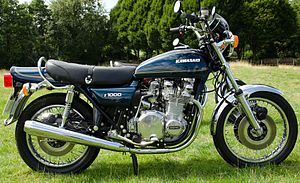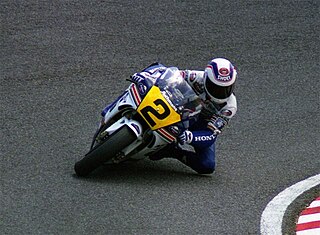
Wayne Michael Gardner is an Australian former professional motorcycle and touring car racer. He competed in the Grand Prix motorcycle racing world championships from 1986 to 1992, most prominently as a member of the Honda factory racing team where he became the first Australian to win motorcycling's premier class in 1987. His success on the world motorcycle road racing circuit earned him the nickname The Wollongong Whiz.

The Kawasaki Zephyr is a range of retro-styled naked superbikes made in the 1990s in Kawasaki's Z series. All models have transverse air-cooled dual overhead camshaft inline-four engines. There were a number of Zephyr models, in four engine capacities, 400, 550, 750, and 1,100 cc.

Frederick Burdette Spencer, sometimes known by the nickname Fast Freddie, is an American former world champion motorcycle racer. Spencer is regarded as one of the greatest motorcycle racers of the early 1980s.

Erv Kanemoto is an American former Grand Prix motorcycle mechanic and motorcycle race team owner. He was one of the most successful motorcycle racing tuners and race team crew chiefs of the 1970s through the early 2000s, working with motorcycle racers who won two national championships and six world championships. He is best known for his association with motorcycle racers Gary Nixon and Freddie Spencer.
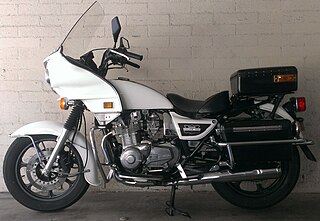
Kawasaki police motorcycles have been produced in four series:
Wester Steven Cooley,, better known as Wes, was an American former motorcycle road racer in the AMA Superbike class. He won the 1979 and 1980 AMA Superbike Championships on a Yoshimura Suzuki GS1000s.
The Kawasaki Z1000 is a four-cylinder motorcycle introduced in 2003 with streetfighter or standard styling. The Z1000 was first introduced in 1977 superseding the previous 903 cc capacity Z1/Z900.

The Kawasaki Z1 is a four-cylinder, air-cooled, double-overhead camshaft, carbureted, chain-drive motorcycle introduced in 1972 by Kawasaki. Following the introduction of Honda's CB750 in 1968, the Z1 helped popularize the in-line, across-the-frame four-cylinder, a format that became known as the Universal Japanese Motorcycle or UJM.
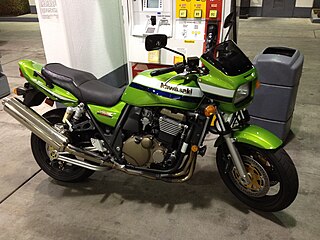
-The Kawasaki ZRX1200R is a standard/naked motorcycle and was manufactured in Japan from 2001 until 2007. It was sold in the US until 2005 and in Europe until 2007. It was updated in 2008 with a six-speed transmission and fuel injection. It was sold exclusively in Japan as the ZRX1200 DAEG model until 2016. It is an evolution of the ZRX1100, a stylized replica of the "Eddie Lawson Replica" KZ1000R sold in 1982, a motorcycle made famous, by the superbike racing champion of the same name. With the ZRX1200R, Kawasaki's goal was to produce a motorcycle with the performance of a modern motorcycle, while retaining a design similar to the original Eddie Lawson Replica.
Hideo "Pops" Yoshimura was a Japanese motorcycle tuner, race team owner, and manufacturer of specialty motorcycle accessories. He is remembered for his ties to the beginnings of Superbike racing and the Yoshimura factory racing team.
Rob Muzzy is an American owner of Muzzy's Performance Products, a specialty engineering company that designs, manufactures and sells high performance parts for motorcycles. He is also a successful motorcycle racing team owner, winning national and international championships in motorcycle road racing and drag racing. His contributions to motorcycle racing resulted in his induction into the AMA Motorcycle Hall of Fame.

Akrapovič d.d. is a Slovenian manufacturer of exhaust systems that began in 1990 in the motorcycle market, and expanded into automobile exhausts in 2010. A global exhaust supplier in motorcycle sport, Akrapovič exhausts are used on motorcycles in Moto GP, superbike, supersport, supermoto, motocross, enduro and rally raid. As of May 2010, Akrapovič systems have been used in a total of 38 world championships, all across motorsport.

The Yamaha FZ750 is a sports motorcycle produced by Yamaha Motor Corporation between 1985 and 1991. The FZ750 is notable for several reasons, perhaps the most radical being the 5-valve cylinder head with a radial arrangement. This became something of a Yamaha trademark. The FZ750 would be the first bike in the Genesis design concept.
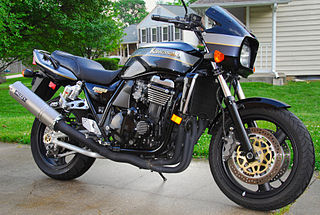
The Kawasaki ZRX1100 was a standard motorcycle made by Kawasaki from 1997 to 2000 with an engine loosely based on the ZX-11. It replaced the Zephyr 1100. Since the Zephyr 1100 sold poorly in the US, the ZRX1100 was not initially sold in that market until 1999. In 2001, the ZRX1100 was replaced by the larger engined ZRX1200, that were sold in the US until 2005. They were updated in 2008 and still sold in Japan as the ZRX1200 DAEG model until 2016. The Japanese only "Final Edition" model was sold until 2017.
The Kawasaki GPz1100 B1 and B2 are motorcycles that were manufactured by Kawasaki in 1981 and 1982 respectively. Both models featured a four-cylinder, two-valve air-cooled engine design with a capacity of 1,089 cc. This engine was an evolution of the powerplant used in the previous Kz1000 series, itself descended from the Z1. In 1983 the GPz1100 was completely revamped in both cosmetic styling, suspension and updated engine. The model number changed to ZX1100A1.

Moriwaki Engineering is a Japanese manufacturer of speciality high performance products and motorcycle accessories.

The Kawasaki Ninja 1000 SX is a motorcycle in the Ninja series from the Japanese manufacturer Kawasaki sold since 2011. Other than its name, it is unrelated to the Ninja 1000R produced from 1986–89, or to other Ninja motorcycles.

Craig Vetter is an American entrepreneur and motorcycle designer. His work was acknowledged when in 1999 he was inducted into the AMA Motorcycle Hall of Fame.
The Kawasaki Z series is a family of standard/naked bikes manufactured by Kawasaki since 1972.
